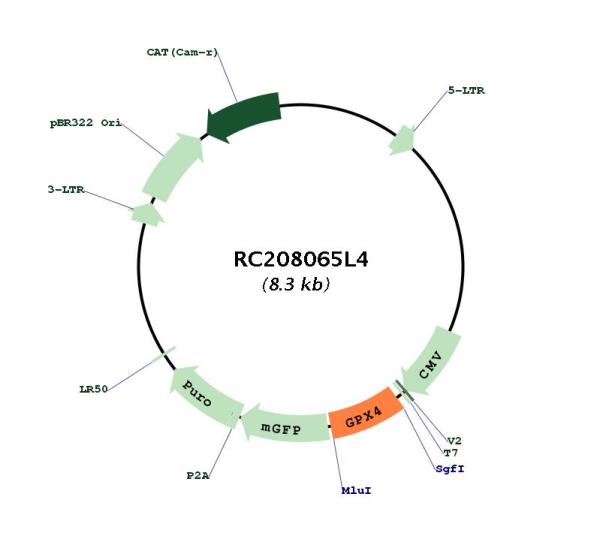Glutathione Peroxidase 4 (GPX4) (NM_002085) Human Tagged Lenti ORF Clone
CAT#: RC208065L4
- LentiORF®
Lenti-ORF, GPX4 (mGFP-tagged) - Human glutathione peroxidase 4 (phospholipid hydroperoxidase) (GPX4), transcript variant 1, (Note: selenocystein protein, Internal stop codon present. See Summary below)
"NM_002085" in other vectors (7)
USD 365.00
Specifications
| Product Data | |
| Type | Human Tagged ORF Clone |
| Tag | mGFP |
| Symbol | Glutathione Peroxidase 4 |
| Synonyms | GPx-4; GSHPx-4; MCSP; PHGPx; SMDS; snGPx; snPHGPx |
| Vector | pLenti-C-mGFP-P2A-Puro |
| E. coli Selection | Chloramphenicol (34 ug/mL) |
| Mammalian Cell Selection | Puromycin |
| Sequence Data |
The ORF insert of this clone is exactly the same as(RC208065).
|
| Restriction Sites |
SgfI-MluI
Cloning Scheme for this gene
Plasmid Map

|
| ACCN | NM_002085 |
| ORF Size | 591 bp |
| OTI Disclaimer | The molecular sequence of this clone aligns with the gene accession number as a point of reference only. However, individual transcript sequences of the same gene can differ through naturally occurring variations (e.g. polymorphisms), each with its own valid existence. This clone is substantially in agreement with the reference, but a complete review of all prevailing variants is recommended prior to use. More info The expression of this clone is not guaranteed due to the nature of selenoproteins. |
| OTI Annotation | This clone encodes a selenoprotein containing the rare amino acid selenocysteine (Sec). Sec is encoded by UGA codon, which normally signals translational termination. Expression of this clone is not guaranteed due to the nature of selenoproteins. |
| Product Components | The ORF clone is ion-exchange column purified and shipped in a 2D barcoded Matrix tube containing 10ug of transfection-ready, dried plasmid DNA (reconstitute with 100 ul of water). |
| Reconstitution | 1. Centrifuge at 5,000xg for 5min. 2. Carefully open the tube and add 100ul of sterile water to dissolve the DNA. 3. Close the tube and incubate for 10 minutes at room temperature. 4. Briefly vortex the tube and then do a quick spin (less than 5000xg) to concentrate the liquid at the bottom. 5. Store the suspended plasmid at -20°C. The DNA is stable for at least one year from date of shipping when stored at -20°C. |
| Reference Data | |
| RefSeq | NM_002085.3 |
| RefSeq Size | 936 bp |
| RefSeq ORF | 594 bp |
| Locus ID | 2879 |
| UniProt ID | P36969 |
| Cytogenetics | 19p13.3 |
| Protein Families | Druggable Genome |
| Protein Pathways | Arachidonic acid metabolism, Glutathione metabolism |
| Gene Summary | The protein encoded by this gene belongs to the glutathione peroxidase family, members of which catalyze the reduction of hydrogen peroxide, organic hydroperoxides and lipid hydroperoxides, and thereby protect cells against oxidative damage. Several isozymes of this gene family exist in vertebrates, which vary in cellular location and substrate specificity. This isozyme has a high preference for lipid hydroperoxides and protects cells against membrane lipid peroxidation and cell death. It is also required for normal sperm development; thus, it has been identified as a 'moonlighting' protein because of its ability to serve dual functions as a peroxidase, as well as a structural protein in mature spermatozoa. Mutations in this gene are associated with Sedaghatian type of spondylometaphyseal dysplasia (SMDS). This isozyme is also a selenoprotein, containing the rare amino acid selenocysteine (Sec) at its active site. Sec is encoded by the UGA codon, which normally signals translation termination. The 3' UTRs of selenoprotein mRNAs contain a conserved stem-loop structure, designated the Sec insertion sequence (SECIS) element, that is necessary for the recognition of UGA as a Sec codon, rather than as a stop signal. Transcript variants resulting from alternative splicing or use of alternate promoters have been described to encode isoforms with different subcellular localization. [provided by RefSeq, Dec 2018] |
Documents
| Product Manuals |
| FAQs |
| SDS |
Resources
Other Versions
| SKU | Description | Size | Price |
|---|---|---|---|
| RC208065 | GPX4 (Myc-DDK-tagged)-Human glutathione peroxidase 4 (phospholipid hydroperoxidase) (GPX4), transcript variant 1, (Note, selenocysteine protein, internal stop codon, see reference data summary) |
USD 300.00 |
|
| RC208065L1 | Lenti-ORF, GPX4 (Myc-DDK-tagged)-Human glutathione peroxidase 4 (phospholipid hydroperoxidase) (GPX4), transcript variant 1, (Note, selenocystein protein, internal stop codon, see summary) |
USD 600.00 |
|
| RC208065L2 | Lenti-ORF, GPX4 (mGFP-tagged) - Human glutathione peroxidase 4 (phospholipid hydroperoxidase) (GPX4), transcript variant 1, (Note: selenocystein protein, Internal stop codon present. See Summary below) |
USD 600.00 |
|
| RC208065L3 | Lenti-ORF, GPX4 (Myc-DDK-tagged)-Human glutathione peroxidase 4 (phospholipid hydroperoxidase) (GPX4), transcript variant 1, (Note, selenocystein protein, internal stop codon, see summary) |
USD 600.00 |
|
| RG208065 | GPX4 (GFP-tagged) - Human glutathione peroxidase 4 (phospholipid hydroperoxidase) (GPX4), transcript variant 1, (10ug), (Note: selenocysteine protein, Internal stop codon present. see reference data summary below) |
USD 500.00 |
|
| SC118821 | GPX4 (untagged)-Human glutathione peroxidase 4 (phospholipid hydroperoxidase) (GPX4), transcript variant 1 (10ug), (Note: selenocysteine protein, Internal stop codon present. see reference data summary below) |
USD 462.00 |
|
| SC324086 | GPX4 (untagged)-Human glutathione peroxidase 4 (phospholipid hydroperoxidase) (GPX4), transcript variant 1 (10ug), (Note: selenocysteine protein, Internal stop codon present. see reference data summary below) |
USD 462.00 |
{0} Product Review(s)
Be the first one to submit a review






























































































































































































































































 Germany
Germany
 Japan
Japan
 United Kingdom
United Kingdom
 China
China


